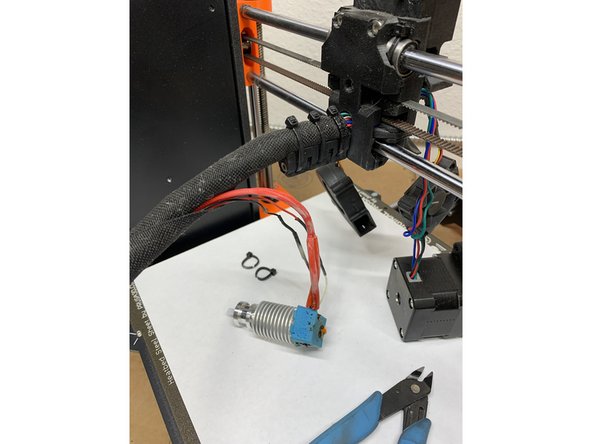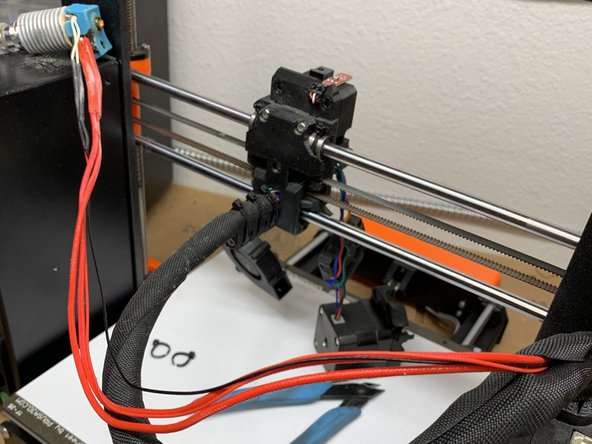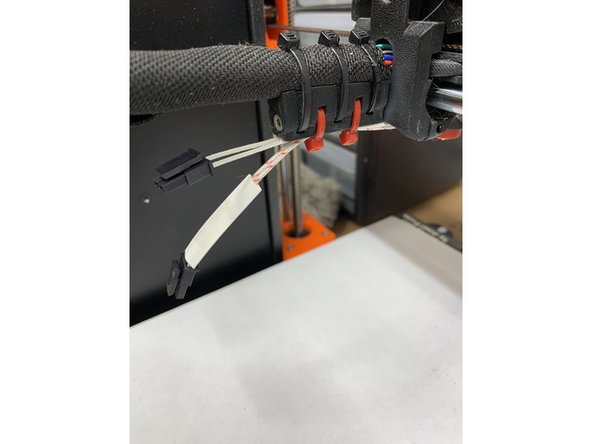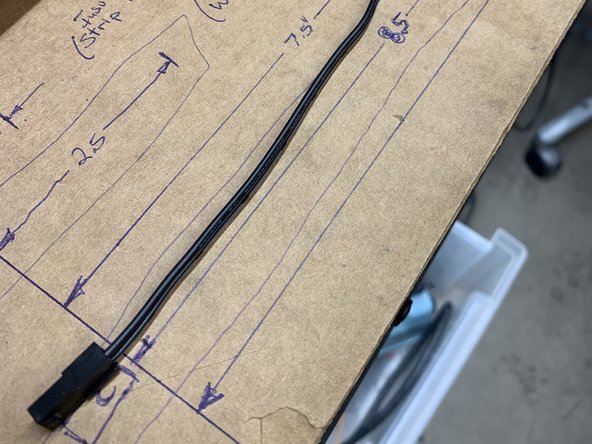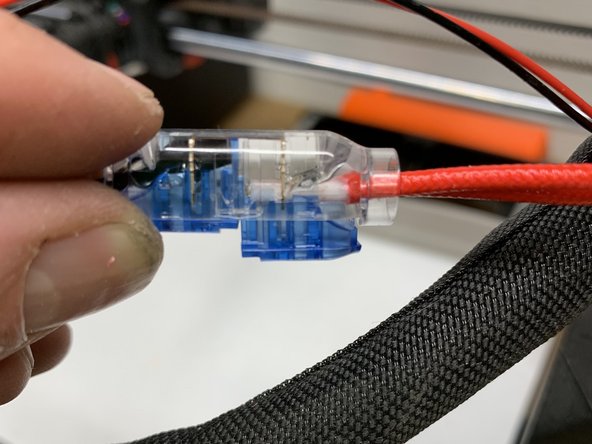Introduction
This is the upgrade method we have employed on the Repkord print farm as it provides the best balance of speed and reliability when doing multiple machines at the same time. At this time we are confident this method will hold up well over time given our testing but if you are at all uncomfortable with this you may prefer to follow the standard METHOD 1 Outlined by E3D.
THIS IS A WIKI! As such it is a living breathing document. If there are details or images that you feel would better help illustrate how to do something please post them here to help others. Thank you to all those who have contributed!
-
-
Disassembly and removal of stock v6 hotend package per official E3D instruction steps 1-7.
-
Opening the wire bundle up by removing the cloth jacket all the way to the control box and exposing the full length of the heater and thermistor wires.
-
Mounting the REVO per official E3D instruction steps 15-21.
-
Cutting the provided extension wires for the heater and thermistor wires to length and prepare them for splicing.
-
Attach the provided thermistor and heater wires that were just cut using the microfit 3 connectors.
-
Cut the stock wiring for the thermistor and the heater to line up with where the other end of the splice connector will be and strip 1 inch off ONLY the outer red cloth jacket of the heater wire. The white silicone insulation MUST remain on the heater wire for a proper splice.
-
Attach the quick splice connectors, replace the wire bundle wrap and zip tie it back to the hot-end.
-
Follow the final calibration steps outlined in the official E3D instructions for first layer and PID calibration.
-
-
-
These splice connectors require no special tools to engage and are designed to handle up to 5A of continuous current, more than enough for this particular application.
-
Wires are NOT to be stripped prior to insertion in the splice connectors, with one exception outlined below. The piercing of the insulation and its support are critical to the function and retention of the wires.
-
The stock heater cartridge wire has a red cloth jacket over the outside of the insulation that must be removed prior to use with this splice connector. You can easily do so with a razor or wire strippers. It is important that you DO NOT STRIP THE WHITE SILICONE INSULATION BENEATH the red cloth jacket. ONLY THE OUTERMOST CLOTH JACKET.
-
-
-
The positioning of these splice connectors in the wire bundle has been carefully chosen to minimize the strain on the connections during 3D printing operations as well as the preventing excess thickness of the bundle in any given space.
-
In this installation we are retaining the quick connect microfit 3 connectors for easy future removal and maintenance.
-
Before you cut any of the stock wiring its important that you cut and position the new extension cables provided with the kits to the lengths specified in step 7. This will dictate exactly where your splice connectors will go. They ARE NOT to be positioned directly next to one another.
-
-
-
Disassemble and remove the stock v6 hot-end package per official E3D instruction steps 1-7.
-
-
-
Open the wire bundle up by removing the cloth jacket all the way to the control box and exposing the full length of the heater and thermistor wires.
-
-
-
Cut the provided extension wires for the heater and thermistor wires to length and prepare them for splicing.
-
Cut the thermistor extension wire (white) as shown in Pic 1 to a length of 2.5 inches (~63mm) from the BACK of the Micro-fit 3.0 connector. This first splice will ultimately be positioned in the wire bundle closest to the hot-end.
-
Cut the heater extension wire (black) as shown in Pic 2 to a length of 8.5 inches (~216mm) from the BACK of the Micro-fit 3.0 connector. This second splice will ultimately be positioned in the wire bundle closest to the control box.
-
Separate one inch (~25mm) of the two conductors from each of the cut ends of the extension cables for the heater and thermistor. Pic 3
-
-
-
Attach the provided thermistor and heater extension wires that were just cut using the microfit 3 connectors.
-
-
-
Cut the stock wiring for the thermistor and the heater to line up with where the other end of the splice connector will be and strip 1 inch off ONLY the outer red cloth jacket of the heater wire. The white silicone insulation MUST remain on the heater wire for a proper splice.
-
The stock Red and Black wires for the thermistor and all of the provided extension cables should be spliced WITHOUT stripping any of the insulation away. This insulation is important for stabilizing the wire and preventing the splice from coming lose over time.
-
-
-
Position the wires of each end into the splice connector all the way into the fitting until it hits the endstop wall inside the connector.
-
Squeeze one end of the splice down at a time watching as the wire is pressed into the knife edge conductors and compress until each button locks firmly in place. You'll notice the insulation wire being curved and locked in place to support the wire. This is by design.
-
For the stock heater wire, again be sure that ONLY the red cloth jacket is stripped off and clear of the crimp. Only the white silicone jacket should be inside and compressed by the splice connector. Pic 2
-
Repeat the process for the opposite side of the splice and for the other set of conductors. Go slowly and again verify that the wire is fully seated inside the splice.
-
Cover all the wiring with the fiber bundle cover and ziptie it back to the hotend bundle mounts.
-
-
-
Follow the final calibration steps outlined in the official E3D instructions for first layer and PID calibration.
-
HIGHLY RECOMMENDED: Some additional things to perform post install- Check your nozzle size setting in HW Setup menu if changed. Run the following Calibrations: Self Test, Full XYZ calibration, Temp Calibration, First Layer Calibration.
-
Cancel: I did not complete this guide.
One other person completed this guide.





